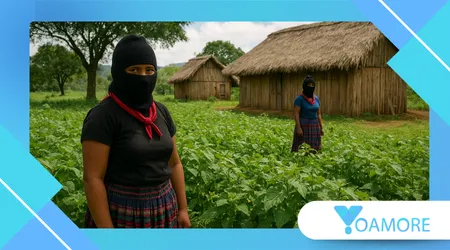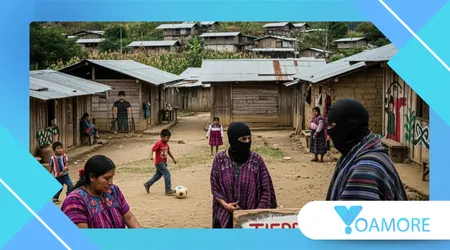Zapatista Villages in Mexico: Life in Autonomous Micro-Societies

For decades, the Zapatista movement in southern Mexico has captured global attention for its bold experiment in self-governance, autonomy, and resistance to neoliberal globalization.
Anúncios
Far from being a relic of the 1994 uprising, Zapatista Villages in Mexico have evolved into thriving micro-societies that challenge conventional ideas of democracy, education, and economic sustainability.
Understanding how these villages function offers a rare glimpse into an alternative system where collective decision-making, community ownership, and indigenous identity are at the center.
Unlike romanticized portrayals, life in these communities is not without challenges, but their resilience and creativity provide valuable lessons for modern societies seeking fairer and more sustainable ways of living.
At a time when disillusionment with political institutions is rising worldwide, the Zapatista experience provides an inspiring case study.
Anúncios
Instead of waiting for reform from above, these villages constructed an entirely different framework from below, proving that marginalized groups can design functional alternatives that endure over decades.
Summary
- Zapatista villages emerged after the 1994 uprising in Chiapas, led by the Ejército Zapatista de Liberación Nacional (EZLN).
- These micro-societies prioritize autonomy, collective ownership, and indigenous rights.
- They operate through participatory democracy, unique educational systems, and local healthcare initiatives.
- Their struggles include external political pressure, limited resources, and the challenge of balancing tradition with modernization.
- Despite obstacles, Zapatista villages remain a global reference for grassroots alternatives to state governance.
This summary provides a quick roadmap, but each element carries much deeper implications.
From the way leaders are rotated to the use of indigenous languages in schools, every choice reflects deliberate resistance to inequality and cultural erasure.
Origins of the Zapatista Movement
The uprising of January 1, 1994, coincided with the implementation of NAFTA, which Zapatistas argued would devastate indigenous farming communities.
Rooted in Mayan traditions, the movement demanded recognition of indigenous rights, fair land distribution, and resistance to exploitation.
From this moment, villages aligned with the EZLN began reorganizing themselves as autonomous territories, free from state or military control.
This shift marked the birth of Zapatista Villages in Mexico, which still operate independently today through structures like the Caracoles (regional centers of governance).
What makes this origin story so compelling is how quickly communities embraced autonomy as a practical solution rather than a symbolic gesture.
Within months, families were building new schools, health posts, and community councils, determined to prove that indigenous self-rule could be more effective than government bureaucracy.
How Zapatista Villages Govern Themselves

Participatory Democracy in Practice
Unlike hierarchical models, Zapatista governance relies on assemblies where decisions are made collectively.
Leaders, known as cargos, are elected but serve on a rotating basis, preventing concentration of power. Accountability is direct—leaders can be removed if the community feels they are not fulfilling responsibilities.
This system emphasizes a principle of “mandar obedeciendo” (to lead by obeying), which reverses the traditional relationship between authority and community.
Anthropologists studying Chiapas highlight that while slow, this method ensures that decisions genuinely reflect the collective will.
It is worth noting that this process requires patience, as debates can extend for hours or days until consensus is reached.
Yet the emphasis on dialogue over speed reinforces community cohesion, creating stronger bonds of trust that go beyond political structures.
+ The Secret World of 11 Unique Cultural Microcosms
Community Justice Systems
Zapatista villages also operate their own justice structures, often preferring reconciliation and restoration over punitive measures.
For instance, conflicts like land disputes or family disagreements are mediated through assemblies, reducing reliance on state courts.
This approach not only prevents costly legal battles but also strengthens communal harmony.
By treating conflicts as shared responsibilities rather than individual failures, the justice system embodies the collective values that underpin Zapatista autonomy.
Education: Beyond Traditional Schooling
Autonomous Schools
One of the most striking features of Zapatista Villages in Mexico is their independent education system.
Teachers, known as promotores de educación, are community members trained by the EZLN.
Instead of following a rigid state curriculum, they focus on bilingual education (Spanish and indigenous languages), history from an indigenous perspective, and practical skills for self-sufficiency.
A study by the Chiapas Support Committee revealed that these schools aim to cultivate critical thinking rather than rote memorization.
Children learn not only about mathematics and science but also about the history of indigenous resistance and ecological responsibility.
This method reflects the Zapatistas’ belief that education should serve liberation, not assimilation.
By grounding lessons in daily life—such as farming techniques or community governance—students are empowered to see themselves as active participants in shaping their future.
Challenges in Access and Resources
Despite their innovation, these schools face obstacles such as lack of funding, limited infrastructure, and occasional pressure from the state.
Yet, families continue to prioritize them, seeing them as essential for preserving cultural identity while equipping future generations with tools to navigate both local and global realities.
International solidarity networks often donate books, computers, and supplies, but the emphasis remains on self-reliance.
This tension between outside support and internal control highlights the delicate balance the Zapatistas strive to maintain: accepting help without compromising autonomy.
+ The Punks of Tijuana: Micro-Resistance Through Music and Style
Healthcare: Healing Outside the State
Zapatista villages have also developed autonomous healthcare systems combining modern medicine with traditional practices.
Clinics within the Caracoles provide basic services, vaccinations, and maternal care, often staffed by volunteer health promoters.
In communities where state healthcare has historically been absent or discriminatory, these clinics fill a critical gap.
Moreover, traditional herbal medicine is preserved and practiced, reflecting a philosophy of balance between indigenous wisdom and contemporary science.
What stands out is the integration of health into broader community life. Clinics are not isolated institutions but part of a network that also includes agricultural cooperatives and schools.
This interconnectedness ensures that healthcare is not just about treating illness but about promoting collective well-being.
Economic Life and Sustainability
Collective Farming and Cooperatives
Agriculture remains central in Zapatista Villages in Mexico, but the model is different from typical capitalist farms.
Land is collectively owned, and production often focuses on corn, beans, and coffee. Coffee cooperatives, in particular, have become internationally recognized, exporting fair-trade products to solidarity networks in Europe and North America.
These cooperatives represent both economic survival and political resistance, proving that alternative trade models can sustain communities without corporate dependence.
They also serve as training grounds for young people, who learn both technical farming skills and the values of collective ownership.
Balancing Tradition and Modernity
While traditional farming practices dominate, some villages have cautiously integrated technologies like solar panels and internet access.
However, these decisions are debated collectively to avoid undermining cultural identity or increasing dependency on external systems.
This careful adoption of technology demonstrates a form of “critical modernity”—embracing tools that improve life while resisting those that could erode autonomy.
The process is slow but intentional, illustrating the Zapatistas’ long-term vision of sustainable independence.
Challenges Faced by Zapatista Communities
Life in autonomy is not without tension. Communities face periodic military pressure, economic embargoes, and accusations from political opponents.
Climate change has also affected crop yields, threatening food sovereignty.
Additionally, internal debates emerge: younger generations often seek more connection with the outside world, while elders prioritize cultural preservation.
These tensions are part of the ongoing experiment in balancing autonomy with adaptation.
Yet, the ability to openly address such conflicts is itself a strength. Instead of fragmenting, communities channel disagreements through assemblies, proving that democratic resilience depends not on avoiding disputes but on managing them collectively.
+ The Roma of Eastern Europe: Culture, Conflict, and Tradition
Global Significance of Zapatista Villages
The endurance of Zapatista Villages in Mexico has inspired activists, academics, and social movements worldwide.
From Occupy Wall Street assemblies to indigenous rights campaigns in Latin America, the Zapatistas are seen as proof that grassroots democracy is possible.
Their ability to maintain autonomy for over three decades, despite immense pressure, positions them as a living laboratory for rethinking governance, sustainability, and community resilience in the 21st century.
By showing that alternatives are not only possible but already functioning, the Zapatistas disrupt the narrative that neoliberal globalization is inevitable.
This symbolic power has made them a reference point not only for indigenous struggles but also for global debates about climate justice, gender equality, and participatory democracy.
+ Why Inuktitut Has a Word That Means “I’m Tired of You”
Table: Key Features of Zapatista Villages
| Aspect | Characteristics | Example/Impact |
|---|---|---|
| Governance | Assemblies, rotating leadership | Prevents concentration of power |
| Education | Bilingual, culturally rooted | Preserves indigenous languages |
| Healthcare | Clinics + traditional medicine | Fills gaps left by state services |
| Economy | Cooperatives, collective land | Fair-trade coffee exports |
| Justice | Community mediation | Emphasis on reconciliation |
| Global Influence | Model for grassroots democracy | Inspires global movements |
Conclusion
Zapatista Villages in Mexico represent more than just political defiance; they are living experiments in alternative governance, cultural resilience, and economic autonomy.
By blending indigenous traditions with innovative practices, these communities challenge assumptions about how societies can be organized.
While not free from difficulties, their persistence demonstrates the power of collective action and imagination.
In a world grappling with inequality, environmental crises, and declining trust in institutions, the Zapatista model continues to provoke critical questions: what if societies truly prioritized community, dignity, and self-determination?
The lessons extend beyond Chiapas. Whether in debates about climate adaptation, education reform, or social justice, the principles guiding Zapatista life offer valuable insights for those seeking more equitable futures worldwide.
Frequently Asked Questions (FAQ)
1. Are Zapatista villages recognized by the Mexican government?
Not officially. They operate autonomously and often face legal and political challenges, though the government tolerates their existence to avoid further conflict.
2. How do Zapatista communities fund themselves?
Through collective farming, cooperatives, and international solidarity networks, particularly coffee exports under fair-trade agreements.
3. Can outsiders visit Zapatista villages?
Yes, but access is controlled. Visitors typically need permission from community assemblies, and stays are often organized through solidarity groups.
4. Do young people stay in Zapatista villages or migrate out?
It varies. Some leave for education or work, but many return to support their communities, contributing to the balance between tradition and modernity.
5. What can the world learn from Zapatista villages?
They demonstrate that grassroots democracy and autonomy are viable alternatives to centralized governance, offering lessons on sustainability, justice, and collective responsibility.
